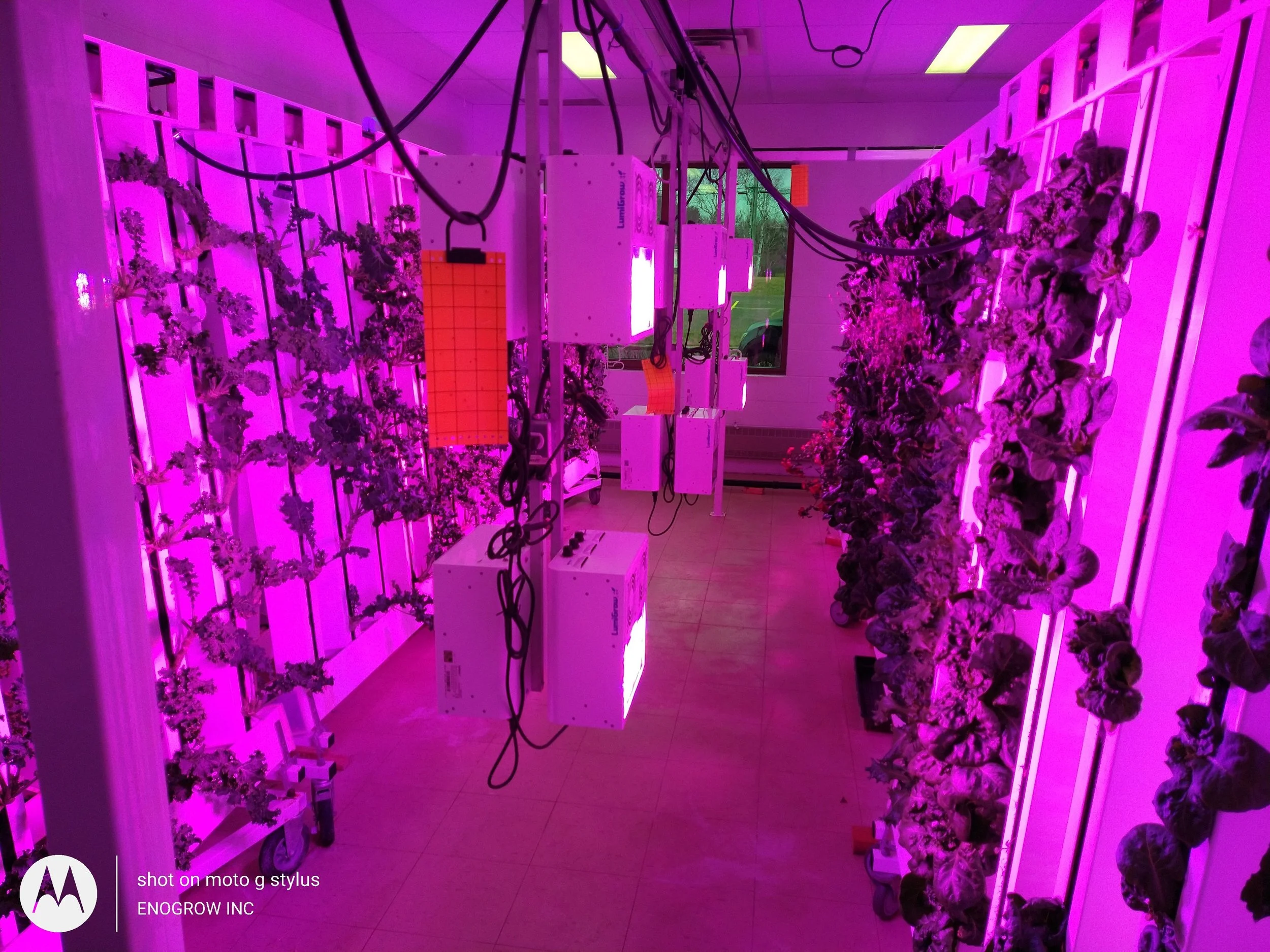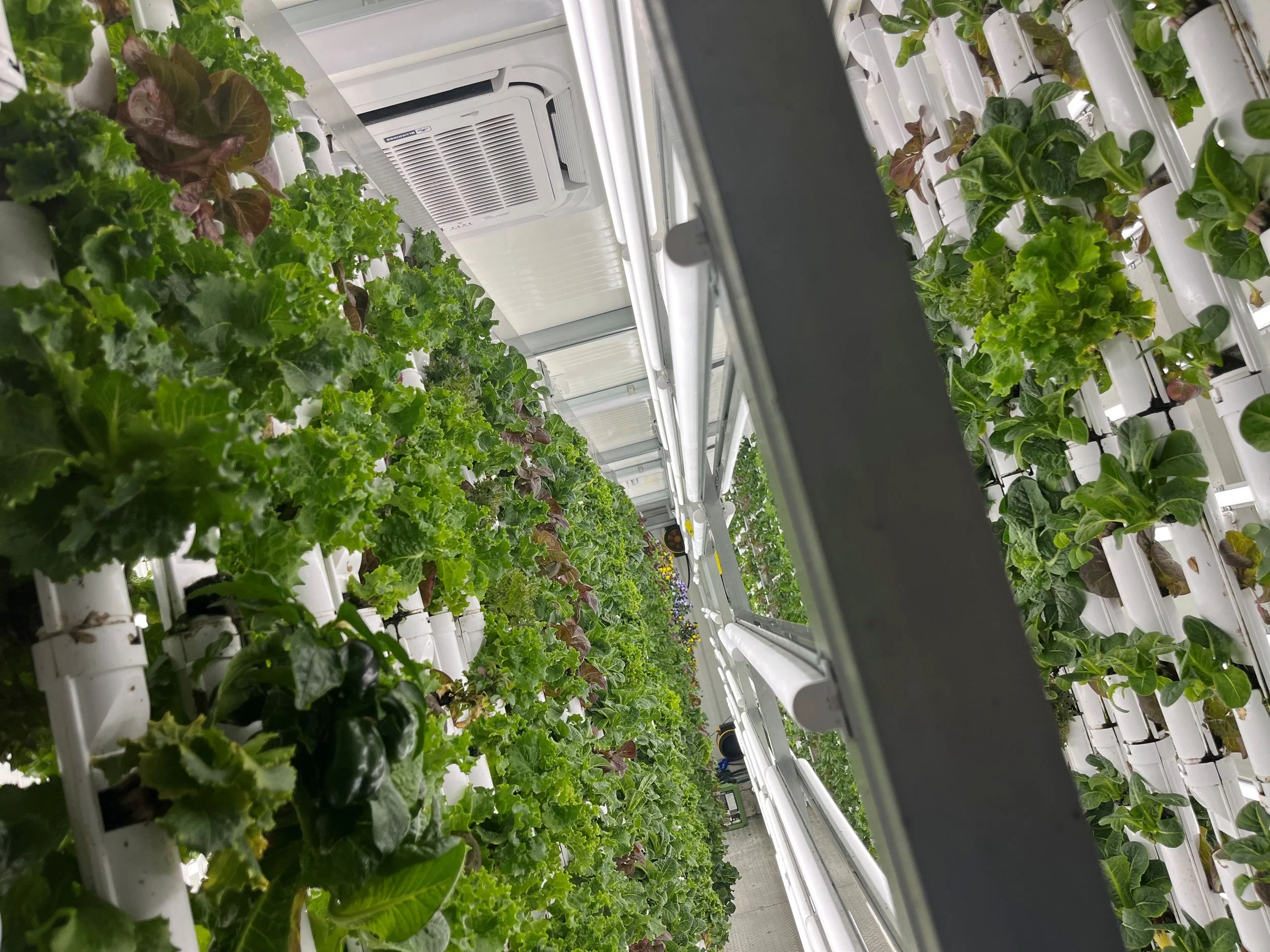A different kind of farmer
Vertical, hydroponic farming in Atlantic Canada is an increasingly smart way to get your greens in a time of growing geopolitical uncertainty, food insecurity, and climate change.
EnoGrow owner Daniel Ratté farming his crop. Photo courtesy of EnoGrow.
Kris Sutton was an aircraft mechanic for 13 years. Now he grows lettuce, a career picked up during the Covid-19 pandemic, and realized on his property in Enfield, Nova Scotia. In some ways, aircraft were simpler.
“When we got the farm,” says Sutton, “I didn’t realize I was going to be a chemist, an electrician, a plumber, as well as a farmer.”
That’s because his is not a traditional farm, with acres, soil, sunlight, and spring rain. His is an indoor, hydroponic, vertical farm, with 9,000 leafy greens growing simultaneously in a 326 square foot shipping container. Each head of lettuce germinates for three weeks in a small nursery, then matures on one of three vertical grow walls for another four weeks, everything awash in LED light. Sutton says he harvests a thousand head a week, every week.
EnoGrow hydroponic farm. Photo courtesy of EnoGrow.
Hydroponics and vertical farming can be paired in a number of ways, but in the case of leafy greens, plant roots are typically suspended in flowing, nutrient rich water, continuously recirculated and refertilized to prevent waste. Sutton’s three grow walls equate to a couple of acres of airable land but use roughly 85 per cent less water than they would under traditional cultivation practices. Lighting, humidity, and temperature are all managed by an inbuilt climate control system and can be tailored to a given crop. The system was prefabricated by FarmBox Foods in Colorado, with a few tweaks from Sutton.
“With this kind of farming, you’re controlling your environment,” says Sutton. “You don’t have to worry about what’s outside.”
This is why vertical hydroponics make sense in a warming climate — food security. Here in Canada, our access to leafy greens is already subject to the uncertainties of international trade, but increasingly, says Sutton, it’s also subject to drought, flood, pest, disease, and wildfire. Sutton’s Vertical Gardens, and operations like it, can be plunked down just about anywhere, and reliably produce greens with a pittance of water, a few bags of powdered fertilizer, and electricity.
Sutton's Vertical Gardens lettuce on vertical grow walls. Photo courtesy of Sutton Farms.
Sutton's Vertical Gardens shipping container farm. Photo courtesy of Sutton Farms.
“We had our first harvest in January,” says Christopher Mitchelmore, CEO of St. Anthony Basin Resources Incorporated, a non-profit in Newfoundland’s Great Northern Peninsula.
Their vertical farm – also set up in shipping container – was manufactured by The Growcer, based in Ottawa. So far, their system is producing a mixture of over seven hundred heads of lettuce, spinach, kale, and arugula each week.
“When you produce something that’s hyperlocal,” says Mitchelmore, “there are definitely positive impacts.”
Those positive impacts include much reduced shipping emissions; the ability to harvest the greens themselves within 24 hours of sale; and customers being shielded from price volatility, which has, in places like Newfoundland, brought the cost of lettuce from $2.99 a head up to $8.99 at times. The only significant input for a system like this, says Michael Thaler, a horticulture research scientist with The Growcer, is the electricity.
“Six thousand to seven thousand kilowatts a month sounds like a lot,” says Thaler, “but that’s equivalent to the average energy consumption of a family of three, and you’re getting six hundred heads of lettuce per week with it. That works out to a gram of produce per kilowatt.”
Many of those kilowatts are spent on cooling in summer, says Thaler. The Growcer shipping container is so well insulated that its LEDs provide sufficient heat in winter to keep crops comfortable. They have systems operating in places like Norway House and Churchill, Manitoba, at -42°C, growing ice on their outer walls, and romaine within. The Growcer’s climate control system keeps plants in a perpetual summer — specifically early summer — accelerating the growth rate of lettuce by a factor of three.
“This will never replace land-based farming,” says Thaler. “There’s no system that produces corn or wheat as cheaply as traditional agriculture, but for lettuce, vertical hydroponics are very, very good.”
Daniel Ratté founded a vertical hydroponic farm in Saint-Léolin, New Brunswick, in 2019, this time without a shipping container; opting instead for École Le Maillon, a decommissioned high school with 24,000 square feet of farmable…floor, now stuffed with a variety of indoor growing systems, some bought commercially, some invented on the spot. Today their farm, EnoGrow, produces 90,000 heads of lettuce each year, alongside ten different varieties of microgreens, as well as some flowers.
“People are really stunned when I tell them our entire operation takes less water than a family of four each month,” says Ratté. “It also uses 98 per cent less space than regular agriculture.”
He, too, points to the importance of these efficiencies in a warming climate. Land and water are at a premium, he says, and vertical hydroponics have the potential to take the pressure off. When paired with renewable power, direct emissions from this kind of farm can be very low.
“Growing indoors presents new challenges,” says Ratté. “But it’s definitely one of the best options we have right now as we deal with the challenges presented by climate change.”
Climate Stories Atlantic is an initiative of Climate Focus, a non-profit organization dedicated to covering stories about community-driven climate solutions.
Sign up for notifications of our latest free articles. You can unsubscribe at any time.




